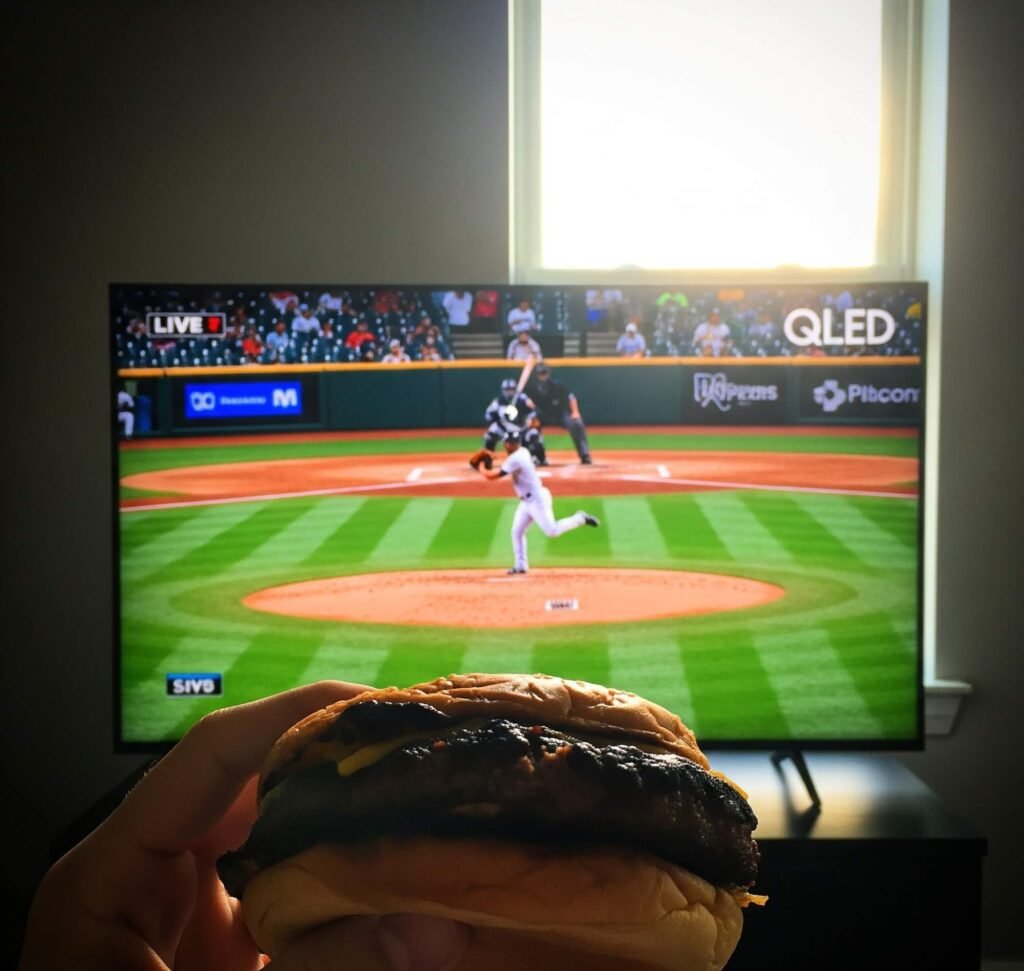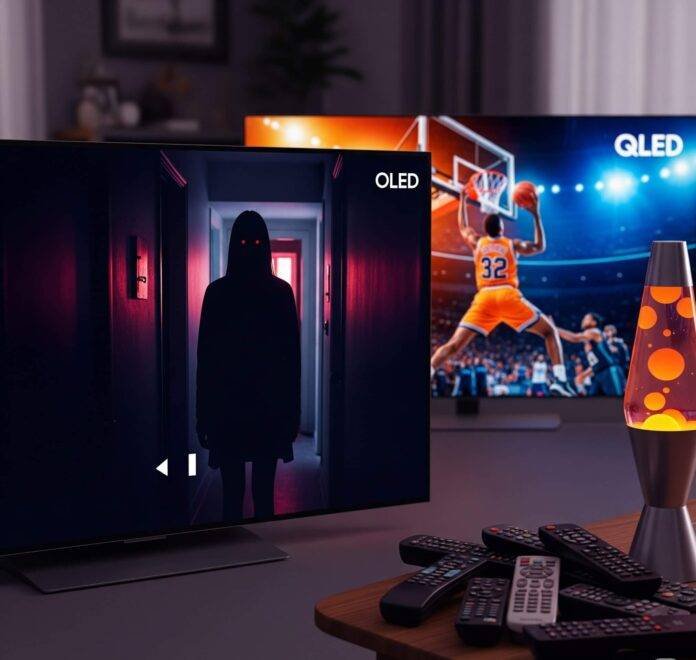So, OLED vs QLED—y’all, I’m knee-deep in this TV tech mess, standing in a Best Buy in Chicago last weekend, my hoodie smelling like the greasy hot dog I scarfed outside. My old TV’s so bad, it makes The Last of Us look like a pixelated Game Boy game. I’m no tech wizard, just a dude who wants to watch Mad Max without the colors looking like a washed-out thrift store painting. The Best Buy guy was throwing around terms like “quantum dots” and “organic pixels,” and I’m like, bro, slow down, I’m still processing the fact I forgot my wallet in my car. Here’s my totally human, slightly unhinged take on OLED vs QLED, written from my messy apartment where I just tripped over a pizza box.
Why I’m Obsessing Over OLED vs QLED
Picture me, okay? I’m in my living room, fairy lights half-burnt out because I bought the cheap ones, trying to convince my friends that my TV’s “retro vibe” is intentional. Spoiler: it’s not. Last movie night, we watched Barbie, and the pink was so dull, my friend Sarah said it looked like Pepto-Bismol gone bad. I started Googling OLED vs QLED at, like, midnight, scrolling X posts and tech blogs until my eyes burned. Both promise killer picture quality, but they’re so different, it’s like picking between tacos and sushi. I even misread a Reddit thread and thought QLED was “CUE-led” for a solid day—embarrassing, I know.
- OLED’s got those deep, deep blacks. Like, turn-off-the-lights-and-get-lost-in-space deep. Perfect for creepy movies like Hereditary.
- QLED’s all about brightness. It’s like the sun decided to live in your TV—great for sports or those nature shows with overly happy narrators.
I learned this after I accidentally ordered a tech book online and then canceled it because I realized it was $60. Whoops.
OLED’s Vibe: My Late-Night Geek-Out
I got to test an OLED at my buddy Jake’s place in Milwaukee, and let me tell you, it was love at first pixel. We were watching Nope, and the night scenes? So dark, I felt like I was hiding from aliens myself. The contrast is wild—every shadow was sharp, like I could reach into the screen. But then we switched to a daytime rom-com, and it was… fine? Not as bright as I thought. Jake, who’s way too smug about his OLED, said it’s not great in super sunny rooms. My apartment’s got these big windows, so I’m stressing. Also, I spilled beer on his couch during the movie—don’t tell him.

QLED’s Glow: My BBQ Disaster
Then there’s QLED. I saw one in action at my cousin’s BBQ in St. Louis, where his living room was brighter than my future. The QLED was showing a Cardinals game, and the colors were popping so hard, I forgot about my overcooked burger. The reds and greens were like, BAM, in your face. But later, we tried watching The Matrix, and the dark scenes looked kinda gray, like my laundry when I mix colors and whites. QLED’s great for sunny rooms or sports, but it’s not giving me that “I’m in the movie” vibe I want for my Star Wars binges.

OLED vs QLED: My Messy Pros and Cons List
Alright, here’s my attempt at breaking down OLED vs QLED, but I’m warning you, I’m no expert, and I might’ve mixed up a spec or two. I’m just a guy who wants a TV that doesn’t make Avatar look like a bootleg DVD.
- OLED Pros:
- Blacks so dark, they’re basically a void. Great for horror or sci-fi.
- Viewing angles are clutch—looks good even if I’m lying on the floor after too many snacks.
- Colors are chill, not like a neon sign exploded.
- OLED Cons:
- Not super bright. My sunny apartment might hate it.
- Burn-in scares me. I once left my TV on a paused Netflix menu for two days (don’t judge).
- QLED Pros:
- Bright like a summer day—perfect for my fishbowl of a living room.
- No burn-in drama, so I can be lazy with my remote.
- Usually cheaper, which is key since I spent $20 on fancy ramen yesterday.
- QLED Cons:
- Blacks are more like “eh, gray.” Not great for dark movies.
- Viewing angles suck if you’re not front and center. My movie nights are chaotic, so that’s a problem.
For the real nerdy details, peep TechRadar’s OLED vs QLED guide—they know way more than me, who’s just winging it here.
My Dumbest OLED vs QLED Mistake
Here’s where I fess up: I almost bought a QLED during a late-night Amazon binge, hyped up by a “limited-time deal” and three cups of coffee. I was so close to clicking “buy” when I realized my living room’s basically a tanning salon with all that sunlight. But then I remembered I’m obsessed with dark, moody shows like True Detective. A QLED would’ve been a total mismatch. I dodged a bullet, thanks to a random Tom’s Guide article I found at 4 a.m. Pro tip: don’t shop for TVs when you’re sleep-deprived and wired on caffeine.

So, What’s the Verdict on OLED vs QLED?
Real talk? I’m still torn, and it’s stressing me out. OLED’s got me drooling for those cinematic nights when I’m wrapped in a blanket, pretending I’m in a fancy theater. But QLED’s brightness is calling my name since my apartment’s like a lighthouse. If I had to choose right now, I’d probably go OLED because those blacks are chef’s kiss, but I’m paranoid about burn-in since I’m the guy who leaves the TV on the Xbox dashboard all night. Like, who does that? Me, apparently.
If you’re picking between OLED vs QLED, think about your vibe. Dark room and love gritty dramas? OLED’s your pick. Bright space and into sports or cartoons? QLED’s got your back. Don’t be like me and almost drop a grand without a plan. Check out your room, your shows, and maybe don’t shop at 4 a.m.
Outbound links:















































